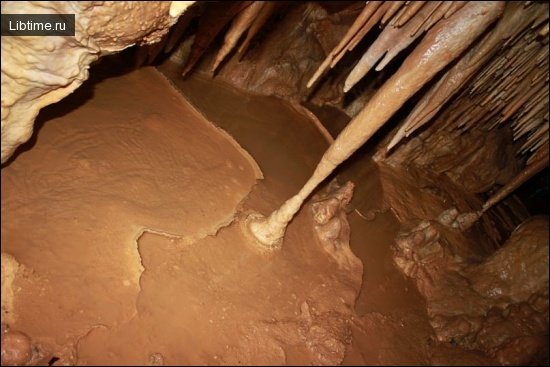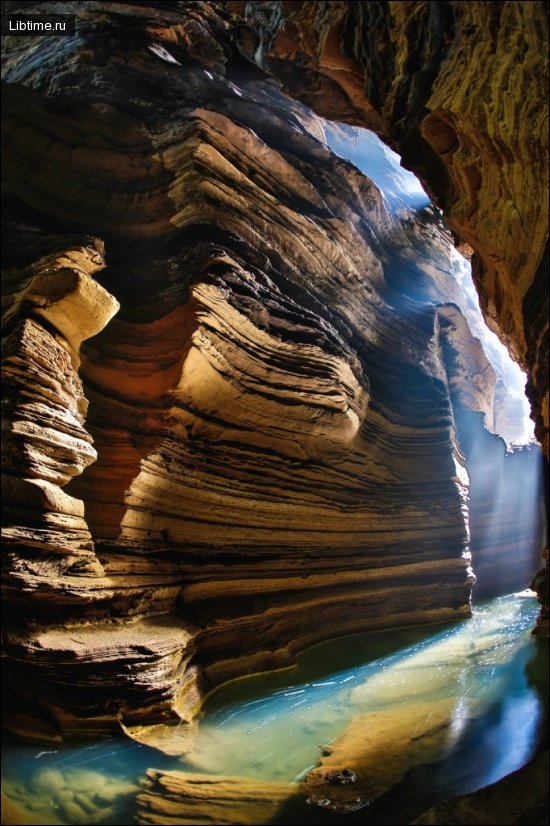Red Cave
The Red Cave is located in Crimea (Ukraine) on the western slope of the Dolgorukovsky massif near the village of Perevalnoye, 23 km from Simferopol, Ukraine. It was formed in the Upper Jurassic limestone.
The main part of the cave from the Second to the Fifth collapse hall has a north-west direction and is laid on the fall of limestone beds, but the main role in the formation of underground cavities and in the distribution of karst runoff belongs to tectonic fracturing. 
Parts of the Red Cave
In the near part of the Red Cave are distinguished Upper, Middle (Wind - Iel-Koba) and Lower (Dark - Kharanlih-Koba) caves, which used to be considered independent.
The Middle part (Vetrovaya) was first described and photographed in the first half of the 19th century by Dubois de Monpere. A fairly complete description of the Red Cave, illustrated with plans of its main passages for more than 400 m, was given in the early XX century. P. Petrov.
In 1915. A. N. Stakhovsky and N. Sukhorukov discovered the passage from the Vetrovaya Cave to the Dark Cave and proved that they are a single underground system. In 1950-1955 in the Red Cave worked Alushta local historians V. Smirnov and I. Kirillov, who made a section of the near part of the cave.
From 1958 to 1966 the cave was investigated by the Complex Karst Expedition of the Institute of Mineral Resources of the Ministry of Geology of the Ukrainian SSR. A detailed study of this complex underground cavity was carried out and it was established that it is the most significant cave in the former USSR in terms of length in carbonate rocks, (more information: Underground leaching). 
Structure and rivers of the Red Cave
The total length of the underground galleries of the Red Cave is 13,100 meters. There are six different-aged floors in the cave, which are especially pronounced in the near part of the cave (up to the First Siphon).
In the siphon part of the cave the sixth floor is not traceable, and the second - fifth floors are found only in some parts of the cave. In places, huge collapse grottoes cover several floors of the cave.
During the formation of the sixth floor of the Red Cave, the water of the Subotkhan River was absorbed by the Averkiev Mine, and the fourth - first floors - by the Proval Mine.
The galleries of the Red Cave do not coincide hypsometrically with the Salgir River terraces, which makes it difficult to determine their age. According to geomorphological and paleozoological studies, the sixth floor of the cave began to form in the late Pliocene, the fourth - in the Lower Pleistocene, the third - in the Middle Pleistocene, the second - in the Upper Pleistocene, and the first - in the early Holocene.
The Red Cave is characterized by large grottoes and long wide galleries, which sometimes have the appearance of an underground canyon eroded by water along a huge fissure. The formation of the largest grottoes is associated with the collapse of the floors of the upper floors in zones of intense tectonic fracturing. One of such grottoes is the Fifth Collapse Grotto, which ends the main passage of the Red Cave.
It is about 80 m long and 30 m wide. This grotto is covered with giant blocks of limestone. Very interesting is the hall of the Blue Drop, the height of which reaches 60 meters. The underground river flows along the bottom of the cave almost all along its length, which in the low-water period forms a system of underground flowing lakes up to 100 m long, 5-8 m wide and 2-4 m deep.
The average annual discharge of the underground river is 0.1 m3/sec. The low-water discharge of the Red Cave River does not exceed 7-8 l/sec, while in spring during snowmelt it increases almost 750 times. At the same time, the water level in some grottoes rises by 8-10 m compared to the low-water level.
The number and flow rate of karst springs on the tuff site located 17 m below the entrance to the Dark Cave are connected with the change of water flow in the river.
In the fall, there are only five downward karst springs on the tuff site, while in the spring there are 30 of them, including seven griffins, i.e. upward springs. The water of the underground river has a carbonate-chloride-calcium-sodium composition. Mineralization is 320-360 mg/l.
The water temperature of the underground river and main springs varies during the year from 9.2 to 9.8°. The beginning of the Red Cave River is the Subotkhan River, which goes into the Proval Mine, located in the southern part of the Dolgorukovsky Massif, 5 km in a straight line from the entrance to the cave. From the Proval mine towards the Red Cave there is a rather wide inclined gallery.
It is washed along the sandstone bed between two slabs of limestone. The total length of this gallery is 1265 meters. Between the end of the gallery and the Fifth Collapse Grotto there are 1700 m in a straight line. The underground river is also fed from the catchments of the western basin of the Dolgorukovsky plateau, where the large Averkiev mine with a depth of 145 m and a total length of horizontally inclined passages of 405 m is located.
In addition, lateral tributaries of the Red Cave River (Overhanging Vaults gallery) drain the Bezarobinskaya Basin located north of the Red Cave system. Fluorescein staining of the water showed that the water from the Proval Mine to the tuff site, where the Red Cave River comes to the surface, flows for 39 days in low water and less than two days in high water.
The air temperature in the cave is 9.8-11.6°. In some entrance galleries it rises to 18° in summer, in winter it drops to -5° and on their arches there are garlands of ice stalactites. 
They occur approximately every 60 m; this periodicity is broken only in zones of intense tectonic fracturing. The development of calcite cascades is associated with the precipitation of calcium carbonate due to changes in the temperature of the underground flow. A total of 36 cascades were noted in this part of the cave. Moon milk was found in the gallery of Overhanging Vaults.
Another mineralogical rarity are original gypsum flowers growing on the surface of limestone blocks in one of the galleries near the First Siphon. Bones of a cave bear, hare, hamster, and alpine jackdaw and tussock have been found in Red Cave.
Remains of the Kizil-Kobin culture, dating back to the Late Bronze Age and the beginning of the Iron Age, were found on the tuff site at the entrance to the Red Cave. The Kizil-Kobins, who lived in the VII-VI centuries BC, according to some researchers, are descendants of the Cimmerians and ancestors of the Taurians.


